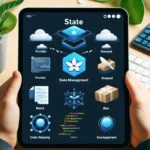Introduction
Responsive design is crucial in today’s multi-device world. With Flutter, you can create applications that adapt to different screen sizes and orientations. This guide will cover essential Flutter widgets and techniques for building responsive UIs.
Table of Contents
- Understanding Responsive Design
- MediaQuery
- LayoutBuilder
- Expanded and Flexible
- AspectRatio
- FittedBox
- Custom Responsive Widgets
- Best Practices
- Conclusion
Understanding Responsive Design
Responsive design ensures your app looks and functions well on various screen sizes, from small phones to large tablets. It involves using flexible layouts, scalable elements, and adaptable widgets.
MediaQuery
The MediaQuery widget provides information about the size, orientation, and other properties of the device screen.
dartCopy codeMediaQueryData mediaQueryData = MediaQuery.of(context);
double screenWidth = mediaQueryData.size.width;
double screenHeight = mediaQueryData.size.height;
bool isPortrait = mediaQueryData.orientation == Orientation.portrait;
Use MediaQuery to adjust layouts based on screen dimensions.
dartCopy codeContainer(
width: screenWidth * 0.8,
height: screenHeight * 0.2,
child: Text('Responsive Container'),
)
LayoutBuilder
The LayoutBuilder widget builds a widget tree based on the parent widget’s size constraints. It’s useful for creating adaptable layouts.
dartCopy codeLayoutBuilder(
builder: (context, constraints) {
if (constraints.maxWidth > 600) {
return Text('Large Screen');
} else {
return Text('Small Screen');
}
},
)
Expanded and Flexible
The Expanded and Flexible widgets are used within a Row or Column to create flexible layouts that adapt to available space.
Expanded
dartCopy codeRow(
children: [
Expanded(
child: Container(color: Colors.red, height: 100),
),
Expanded(
child: Container(color: Colors.blue, height: 100),
),
],
)
Flexible
dartCopy codeRow(
children: [
Flexible(
flex: 2,
child: Container(color: Colors.red, height: 100),
),
Flexible(
flex: 1,
child: Container(color: Colors.blue, height: 100),
),
],
)
AspectRatio
The AspectRatio widget forces a child widget to have a specific aspect ratio.
dartCopy codeAspectRatio(
aspectRatio: 16 / 9,
child: Container(color: Colors.green),
)
FittedBox
The FittedBox widget scales and positions its child within itself according to fit properties.
dartCopy codeFittedBox(
fit: BoxFit.contain,
child: Text('Scaled Text'),
)
Custom Responsive Widgets
Create custom responsive widgets by combining various widgets and techniques.
dartCopy codeclass ResponsiveWidget extends StatelessWidget {
final Widget largeScreen;
final Widget smallScreen;
ResponsiveWidget({required this.largeScreen, required this.smallScreen});
@override
Widget build(BuildContext context) {
var screenWidth = MediaQuery.of(context).size.width;
if (screenWidth > 600) {
return largeScreen;
} else {
return smallScreen;
}
}
}
Use the ResponsiveWidget to display different layouts based on screen size.
dartCopy codeResponsiveWidget(
largeScreen: Text('Large Screen Layout'),
smallScreen: Text('Small Screen Layout'),
)
Best Practices
- Use Relative Sizes: Use percentages or flexible widgets instead of fixed sizes.
- Test on Multiple Devices: Ensure your app looks good on different screen sizes and orientations.
- Utilize MediaQuery and LayoutBuilder: Adapt your layouts based on device dimensions and constraints.
Conclusion
Building responsive designs in Flutter is essential for creating applications that provide a great user experience across various devices. By utilizing widgets like MediaQuery, LayoutBuilder, Expanded, and Flexible, and following best practices, you can ensure your Flutter apps are both beautiful and functional, no matter the screen size. Keep experimenting with different layouts and techniques to master responsive design in Flutter. Happy coding!
